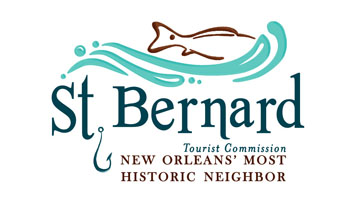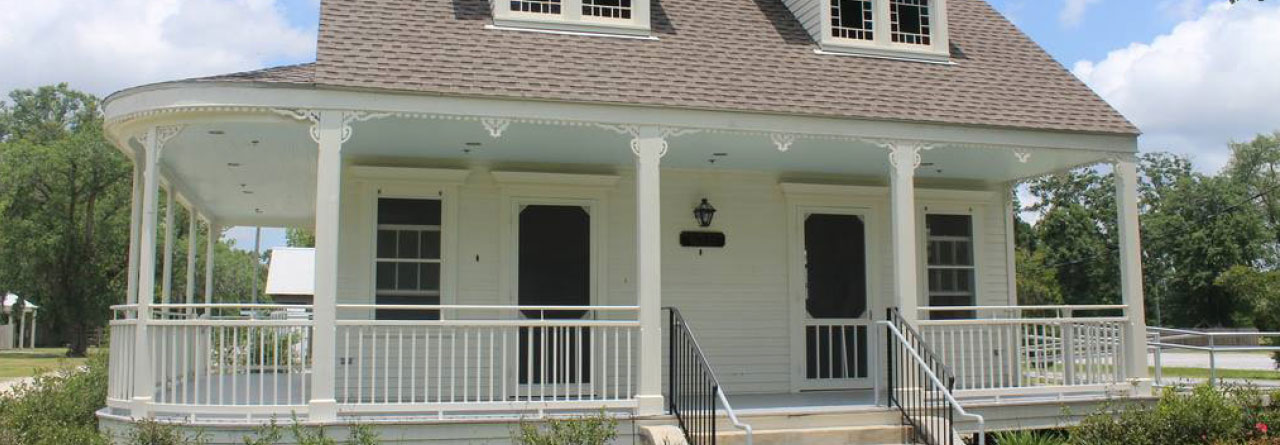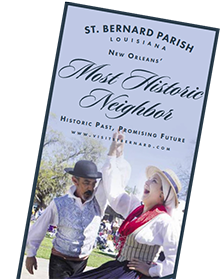Los Isleños Heritage and Cultural Society began to evolve in 1975 from work undertaken by St. Bernard Parish Historian Emeritus Frank Fernandez in conjunction with New Orleans Public Television Station WYES. Fernandez organized a group of septuagenarian and octogenarian oral history informants whose interviews documentary entitled "Louisiana's Disappearing Spanish Legacy." The documentary first aired in September 1975 and generated great enthusiasm in the St. Bernard Isleño Community.
Frank Fernandez was born in St. Bernard Parish (County) in 1918, the son of a Spanish immigrant and an Isleša. He pursued his higher education in Loyola University of the South where he received undergraduate and graduate degrees in English, Spanish and Education. His lifelong interest in history and education resulted in his appointment as Parish Historian for St. Bernard Civil Parish in 1967. It was Fernandez who began the research, which traced the origin of most of St. Bernard's 18th and 19th century Hispanic families to the Canary Islands.
Political and economic upheaval in Spain following the Napoleonic occupation of the Iberian Peninsula (1808-1815) continued through the 19th century. Instability in every facet of Spanish life persisted in the 20th century until the Spanish Civil War and the empowerment of General Francisco Franco as "caudillo" or leader of Spain. Spanish expatriates streamed into New Orleans throughout the 1800s and early 1900s, met Isleño trappers, fishermen and farmers in the French Market and settled in the Spanish speaking Isleño communities of eastern St. Bernard Parish. Their presence in St. Bernard reinforced the Spanish linguistic and cultural identity. Despite other regional influences, the Spanish dialect spoken in eastern St. Bernard remains distinctly Canarian.
The presence of Galicians, Andalusians, Catalans, Basques and immigrants from every region of Spain over two centuries muddle cognizance of the founding period of St. Bernard Parish by colonists from the Canary Islands. Interviews conducted by Alcee Fortier, a famous Louisiana historian, established that the Isleño community had forgotten its place of origin a century earlier, in the Canaries.
The first formal organizational meeting of Los Isleños Society was held January 19, 1976 in the Delacroix Island Community Center. Thirty-one Isleño stalwarts participated in the meeting. The Society organized its first cultural festival in 1976 on the grounds surrounding the Delacroix Community Center. Various programs and traditional Isleño food were served inside the Community Center. More than 15,000 visitors from St. Bernard and the Metropolitan Area participated in the festival.
The Society was first named Los Isleños Heritage Club. Its first president was Delacroix Island native Donald Alvin Diaz. Diaz was bilingual in Spanish and English and preserved a passionate respect for the culture he was born into throughout his life. He worked tirelessly with his fellow officers and directors to firmly establish the Society.
Through the efforts of former Spanish Consul at New Orleans Jose Montero de Pedro, Marques de Casa Mena, the Spanish Government underwrote the expense of sending a delegation of St. Bernard Isleño descendants to Gran Canaria in 1977. This occasion marked the first official contact between St. Bernard and the Canaries since the 18th century migration of Canarian colonists to Louisiana. The St. Bernard delegation was led by Frank Fernandez and Marie Louise Molero O'Toole, a prominent Isleño businesswoman and benefactor of the Society. The delegation visited important historic and cultural sites in Gran Canaria including the Casa de Colon Museum. This important facility is housed in a former residence of the famous explorer Christopher Columbus. This first trip initiated relations, which have continued to develop through the present.
In observance of the bicentennial anniversary of the arrival of Isleño colonists in Louisiana, the Society celebrated a High Mass in the St. Louis Cathedral June 15, 1978 and organized "Noche Española" July 7, 1978. Several hundred members and guests attended both programs. Andres Caparros, a popular Spanish singer from Andalusia, was the featured performer for "Noche Española."
From 1976 to 1980, "Noches de las Decimas" were annually either in the basement of San Pedro Pescador Church or the Delacroix Island Community Center, which functioned as the first headquarters of the Society. The Decima Nights were held to honor senior citizens of Isleño descent living in the easternmost villages of St. Bernard Parish. The traditional folk ballads of the Isleños, known as "decimas," were sung and, indeed, very little English was spoken during these gatherings. It was singularly fascinating to hear 18th century Spanish spoken by the elderly and observe them interacting. Except the manner of dress and ever-present conveniences of 20th century life, one felt transported to the 18th century. These gatherings, in many ways, marked the end of an epoch.
During the historic first pilgrimage of St. Bernard Isleños to the Canary Islands in 1977, Frank Fernandez broached the idea of establishing a museum to preserve and interpret the heritage and cultural identity of the St. Bernard Isleños with Louise Molero O'Toole. Mrs. O'Toole and her sister, Mabel Isabel Molero Quatroy, owned a property adjacent to Ducros Historical Museum and Library in St. Bernard Village. Fernandez caused St. Bernard Parish to acquire the Ducros property by donation from Rosa Ducros Tennant in 1971 to establish the first local history museum in St. Bernard Parish, dedicated to interpreting the pre-history and early history of St. Bernard Parish. The property owned jointly by Mrs. O'Toole and her sister consisted of an early 19th century cottage and surrounding acreage which had been the last home in St. Bernard Parish of their parents, Manuel Molero and his wife, Camille Sylvera.
The Molero family donated the house and grounds surrounding their parents' home to Los Isleños Society May 24, 1980. The building was dedicated as El Museo de Los Isleños June 8, 1980 before a gathering of several hundred society members, international historians, journalists and local officials including a former mayor of New Orleans.
The Society donated the property to St. Bernard Parish Government in September 1980, in order to promote its development and ensure proper maintenance of the building and grounds. Parish Government, in turn, entered into a cooperative agreement with the Jean Lafitte National Historical Park relative to the development of Los Isleños Museum. The National Park Service assumed responsibility for designing and installing exhibits and building maintenance.
The Governor-General of the Canary Islands visited St. Bernard Parish and the Isleño Community in 1977, 1981 and 1982. The government of the Canary Islands designated Los Isleños Museum as an international historic site and Los Isleños Society as an "entity abroad" of the Canarian Government in 1991.
Los Isleños Society has sponsored many cultural programs apart from its annual Fiesta. A flamenco-dancing troop from Jaen, Spain, performed before several audiences of thousands in 1978. The Society organized, in conjunction with the Cabildo Insular de Gran Canaria, "Hispanidad '82, Canarian Cultural Journey" in October 1982. The Canarian folkloric group, Roque Nublo, performed five concerts for public school students and adults as part of Hispanidad. The distinguished Spanish historians, Antonio Rumeu de Armas and Antonio Betancourt Massieu, spoke about the role of the Canaries in developing the New World. Seven years later, in 1989, Los Sabandeños, a renowned choral folkloric group performed for audiences in St. Bernard Parish.
Los Isleños Society assumed responsibility for staffing Los Isleños Museum in January 1997, due to Congressional budget cuts affecting the Department of the Interior. Since then, the Society has begun to implement a 20-year master plan for the development of Los Isleños Heritage and Multi-Cultural Park. The park will include Ducros Museum and acreage acquired by donation and purchase. Other ethnic groups who were resident in Louisiana when Isleño colonists first arrived and ethnic groups who settled in Louisiana after Isleño colonization have been invited to establish a presence in the Park. The Isleño identity in Louisiana evolved, in part, through its interaction with the multitudinous ethnic groups, which made Louisiana home in the 18th, 19th and 20th centuries. This cultural interaction is important to comprehending the Isleños, as they exist today.
Los Isleños Heritage and Cultural Society celebrated its 25th anniversary in 2000.
As an immediate result of Hurricane Katrina, the society saw its members spread out across the entire United States. Eventually, many society members returned to St. Bernard and the greater New Orleans Metropolitan area. Members stay active year-round in planning events and fundraisers and organizing the annual Isleños fiesta, a celebration of the Spanish culture and heritage in Louisiana.
Contact the Los Islenos Heritage and Cultural Society
Plan to visit Los Isleños Museum and experience the Isleños of St. Bernard who constitute the last vestige of Spanish Colonial Louisiana.
Meanwhile, you can contact us for more information: 504-277-4681or losislenos.org.
Los Islenos Heritage & Cultural Society: 1357 Bayou Road St. Bernard, LA 70085
Or keep in touch via Facebook
Board of Directors
Officers
- President - Lena Torres Nunez
- Vice-President - Janice Crespo Smith
- Treasurer - Carrie (Menesses) Bernal
- Secretary - William de Marigny Hyland
- Historian - Jerry Glen Estopinal
- Director - Kathy Serpas Ziegler
- Director - Melanie (Ybarzabal) Koons
- Director - Glen Menesses
- Director - Catherine (Ybarzabal) Serpas
- Director - Jimmy Faust
- Sergeant at Arms - Kenny Fernandez
- Sergeant at Arms - Paul J. Lagarde
- Past President - Ben Crowe




